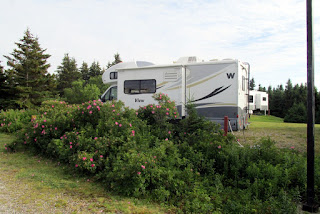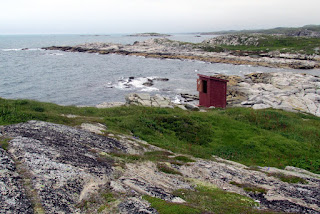We continued south to Doyles, Newfoundland on the
southwest corner of the island. This
area, The Codroy Valley is said to have the most fertile soil on the island The
Grand Codroy Wetland is a very rich estuary and considered a site of
international importance. We stayed at
the Grand Codroy campground, which is
owned by a very friendly and entertaining couple. Shortly after everyone
arrived, the owners hosted a traditional Newfie night, were we would be made
official Newfies. This provided we could pass the tests. To start, we each had to down at least one
shot of the local Screech-which I have previously mentioned, is a rum from the Caribbean. It turned out that there would be more than the
required one shot consumed by many of us.
Next came the language test and most important of
all the rite of kissing the cod. Once
everyone passed, there was a lot of celebratory dancing and other carrying on.
The next day, we took a tour of the valley with the campground owners as our guides, as they
have lived in the valley their entire lives.
Our first stop was the Precious Blood Church built in 1912 by
volunteers. Like a number of churches we
have visited, the interior is more like a ship than a traditional church, since
most of the volunteers made their living on the sea. It was a impressive structure.
Next stop was the Heritage Train Site in Port Aux
Basques. In addition to getting an
insight to the once important role of trains in Newfoundland, the site has an eclectic
collection of memorabilia of the area that was also very interesting. While there are no longer any trains in
Newfoundland, trains were instrumental in getting Newfoundland and Labrador
into the Canadian Federation. When The
Confederation was formed in the 1860's, Newfoundland/Labrador did not
join. After WWII, they
found themselves in desperate financial condition. The Confederation offered them a number of
incentives to join, one of which was the promise to build railroads in Newfoundland
to revive the economy. So, in 1947, they
joined the Confederation as the province of Newfoundland and Labrador.
Next we traveled to the Southern coastal village of
Rose Blanche to visit the Granite Lighthouse. In my mind, this village and lighthouse
really brings home the rough and hostile conditions that generations of
fisherman experienced on this rugged coast. The lighthouse guide told a tale
about how around Christmas one year in the 1930's, the lighthouse keeper left
the lighthouse and walked to town to enjoy a drink with friends. The fishing vessel Monica Hartery trying to make
port crashed on the rocks just offshore. After the fact, some villagers claimed
to have heard some strange cries. In the morning light, a number of bodies were
found on the shore and there were no survivors.
There were many such losses along this coast over the years.
Our last stop was the town of Isle Aux Morte or Dead
Man's Island, so named from the many wrecks that occurred just offshore. The attraction here is the smallest house in
town that is over 100 years old and now serves as a museum. In its past life it was the town's first
school and chapel and is currently a museum for the town.


































8 comments:
This really has been a marvelous excursion for you and I've so enjoyed it.
I agree what a wonderful trip!
How much rum did the cod have to drink to allow you to kiss it? :cP
Y'all have been on a magnificent store. Oh what fun....by taking a shot and kissing the cod. Doesn't get much better than that.
The church is just gorgeous. Thanks for doing such a great job of taking us along on this wonderful excursion. I know I'll never get to that part of the country
What with kissing the fish and whatnot, I thought for a moment that you lost your way and ended up south of the Equator ;-)
We didn't stay at Grand Codroy, but looks like a fun place to spend some time (tho I ain't so sure about the shot and the cod!). Might be as bad as fisherman's brewis or eating cod's tongue (yuk)! Isn't remote and rocky Newfoundland wonderful?
Looks like a wonderful time!
Have really enjoyed your trip.
Post a Comment